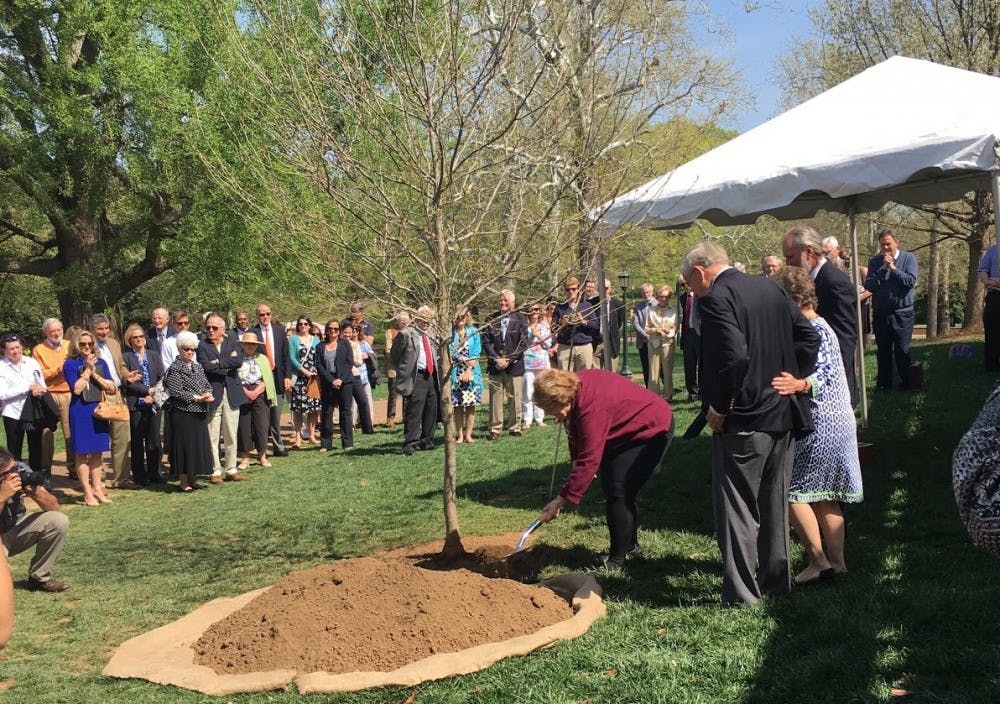As a part of this year’s Founder’s Day, over 70 people gathered on the northwest side of the Rotunda to plant a black tupelo tree in honor of Alexander G. Gilliam, Jr.
The annual tree planting ceremony was started in 1970 to commemorate a member of the University community who has made a substantial and long-lasting impact on Grounds.
Gilliam, more commonly known as Sandy, has a history deeply rooted in the University. Sandy was engaged in an eclectic assortment of roles at the University, including working as an interim dean, an interim vice president, a professor, a guest lecturer and a mentor to a myriad of student organizations, including the Honor Committee and University Guide Service.
However, his most noted service to the University was acting as special assistant to the president under numerous presidents’ tenures between 1975 and 2009, and also serving as secretary to the Board of Visitors. Additionally, Gilliam assumed the position of University Protocol and History Officer until his official retirement in June 2014.
“Kind, generous and service-oriented, Sandy has always been committed both to preserving the history and traditions of the University and to guiding the school through monumental change,” University President Teresa Sullivan said. “His knowledge of the University is encyclopedic, much of it gained first-hand.”
Because he grew up in a family that has been attending the University since 1829, Gilliam has considered the University to be a focal point in his life.
“The University became my alma mater, my second mother, long before I matriculated here, and it has remained so ever since,” Gilliam said. “So this really truly is a very special honor to me.”
The Arboretum and Landscape Committee is responsible for selecting the honoree as well as the species of tree and plot location. Sandy’s tree, a black tupelo, was chosen because of its deep, durable taproot that anchors the tree securely in the ground, symbolic of Sandy’s profound and enduring contributions to the University.
“Mr. Gilliam, you have been a keen planter of seeds of knowledge ever since you arrived at the University more than a half century ago,” a letter written by members of the Seven Society said. “Thanks to your unwavering dedication, Mr. Jefferson’s grounds have blossomed under your watchful eye and gentle care. As one of the most unanimously beloved members of the University family, your roots in this special place are vast and permanent.”
When selecting an honoree, the Arboretum and Landscape Committee does not have a specific set of criteria. The committee accepts external and internal nominations for potential recipients and then discusses the attributes of each candidate and their legacy at the University.
The Committee is headed by chair Worthy Martin and comprised of eight official members, two student representatives, six ex officio members and a fiscal administrator. Architecture graduate student Caroline Herre said as one of the two student representatives, she places a high value on candidates giving back to the student body.
“I can’t speak for the entire committee, but personally [criteria include] dedication to the University, lifelong service and broad impact in their field as well as keeping in mind the student experience and really contributing a lot to that,” Herre said in an interview. “I always like to see honorees have that really good student touch, and I think [Gilliam] totally does.”
After Gilliam shoveled the ceremonious first cup of soil onto his tree, he received an engraved watering can and was greeted by members of the IMP Society that emerged from the Rotunda clad in red hoods with horns. Guests attending the ceremony then each took turns shoveling to finish planting the tree, which will now serve as a living memorial to Sandy’s achievements.
“Sandy has a remarkable and open-minded philosophy about the University,” Sullivan said. “It is fitting, then, to plant this tree in honor of his contributions, because it will be a living, growing, changing monument for a man who believed that, even in light of its strong roots and history, the University must be a living, growing, changing place for it to retain its power to reinvent itself and the world at large.”







